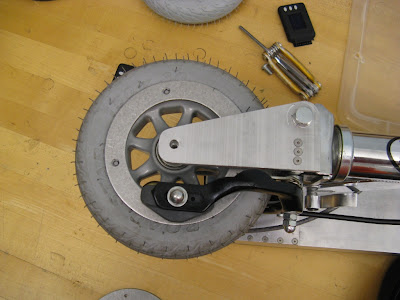It's time that I explain
this. As I've been complaining about ever since I got back from 90ºF and humid Singapore, Cambridge is descending into the darkness of another cold, dry winter. This does not bode well for my small vehicles.
For one, it's too cold to really ride around with anything other than a ski mask and gloves. But apparently people on bikes managed to do it, so maybe I just need to not be a wimp. The bigger problem, which hasn't appeared yet but will in the near future, is the snow/slush/permafrost that covers the streets and sidewalks. Pneumatic tires or not, this is not kick scooter weather.
So is it time to pack up for the winter? Or, is it time for a kick-ass fleet of snowbound vehicles? I think that latter. I won't ruin the other surprises, but I'm ready to introduce my contribution, the smallest and lightest conveyance of the fleet:
The Micro Electro-Maniacal Snowmachine
MEMS
It is an electric...snow scooter. So far as I can tell, there is nothing else that you can possibly put in that category. I
goggled on internet for "snow scooter" and found only manual snow scooters like
this and gas-powered snow scooters like
this. Meet the intersection, a portable electric snowmobile that you stand on. Now, the details:
The dual treads are actually nothing but inverted 2" timing belt (McMaster PN 7959K32). It's sold in open lengths, which means I'll have to join it. But since I'm not using the "timing" part of the timing belt, I can probably get away with some ugliness here. The total length of belt used is about five feet.
There are two drive modules: one fixed at the front and one floating at the rear. The rear drive module slides back and forth for belt tensioning. The two modules are pushed apart by the two massive springs in the gap between them. Together, the springs generate about 100lbf for tensioning. I considered other tensioning methods, but this seemed to be the most direct way to exert force along the pulley centers.
Now the fun part, the drive modules. Starting with the floating rear drive:
Each drive module has a
Banebots P60 gearbox and 540-sized motor contained within the pulley/roller. The bearing arrangement gets interesting. Blowing it up for a better look:
The drive pulley end cap is keyed for the P60 output shaft, and it will be pressed and bonded to the drive pulley itself. That's torque transmission, but what about radial loading? Half the load of each roller goes into the bearing in the side plate. (On the idle pulley, there is a dummy shaft pressed into the end cap.) The other half is taken up by a ring of baby bearings sticking out of the mid plate. Thus each roller is doubly supported without the need for a giant ring bearing. I've never tried this before, but it looks simple enough.
Moving to the front drive module, which totally looks like a swordfish:
The front pulleys contain an identical Banebots P60 gearmotor, but flipped so that it drives the other belt. This was one of the motivating factors for pursuing the two track setup. Lack of timing belts wider than 2" was another. With two tracks, it's possible to exert a bit of differential torque as well, which should help with maneuvering on snow and ice.
The front drive module has another hidden secret:
Yes, for once I am not designing a speed controller for this project. The Victor 883/884 fits the bill just fine and I can cram it into a bulletproof enclosure, not exposed to the outside environment, within the tread volume. The fans are useless in this case, so I'll probably remove them.Two Deans ports and a three-position header port provide access for battery, motor, and signal connections. Motor wires pass through channels in the mid plates to get into the pulleys.
Deans ports entering the waterproof Victor box.
Wire entry channels for the embedded gearmotors.
And last, the ski, which steals its Razer A3 interface from Pneu Scooter's
front fork:
The Razer A3 handlebar bolts to the deck, and the ski attaches where the fork/suspension pin goes. Speaking of Pneu Scooter, I've got two spare wheels...
Could be useful for on-road testing...
So that's it, a tread drive entirely contained in 3" of height under the deck of a scooter. The batteries will have to be external, but that's okay because there is no shortage of space on the top of the deck this time. It's as long as Pneu Scooter's deck, but because the rear wheel isn't in the way, there's an extra 3" to play with. In total, the weight will be something like 20-25lbs, basically the lightest powered snow vehicle ever?
How about performance? Wellllll that depends a lot on the 540 motors. If I go with the stock BaneBots option, an RS-550, then I'll be targeting a top speed of about 10mph. The good news is that I should be able to get enough torque to pull pretty hard (40-50lbf at the treads). I will be employing direct phase-change cooling on the surface of the motor, so I think I can push the motors pretty much as hard as I want. As always, I have a few back-up plans if I need a bit more power. Let's hope it doesn't come to that...
Let the winter build begin.
























